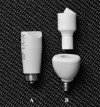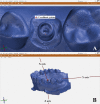Positional transfer accuracy of titanium base implant abutment provided by two different scan body designs: an invitro study
- PMID: 37821890
- PMCID: PMC10568787
- DOI: 10.1186/s12903-023-03399-9
Positional transfer accuracy of titanium base implant abutment provided by two different scan body designs: an invitro study
Abstract
Background: The variabilities in design and material of scan bodies have a major role in the positional transfer accuracy of implants. The purpose of this invitro study was to compare the 3D transfer accuracy (trueness and precision) of titanium base (TB) abutment position provided by 2 different scan bodies: one-piece scan body (SB) in comparison to two-piece healing abutment and scan peg (HA-SP).
Methods: A maxillary model with a dummy implant in the 2nd premolar (Proactive Tapered Implant; Neoss) was 3D printed and TB (Ti Neolink Mono; Neoss) was tightened on the implant and scanned by using a laboratory scanner (inEos X5; Dentsply Sirona) (reference scan). An SB (Elos Medtech) and an HA-SP (Neoss) were subsequently connected to the implant and were scanned 10 times each by using the same scanner (test scans). All the scans were exported as STL files and imported into CAD software where the TBs were formed. Test scans were superimposed on reference scans for transfer accuracy analysis using 3D metrology software (GOM Inspect; GOM GmbH) in terms of angular deviation in vertical and horizontal directions, linear deviation in each XYZ axis of TBs and total linear deviation in all axes. Statistical analysis was done using independent sample t test. When Levene's test for equality of variances was significant, Welch's t-test was used. (P value < 0.05) RESULTS: Significant differences were found amongst the tested groups in both angular and linear deviation in terms of trueness with less deviation values for the SB group (P < 0.001). For the precision, significant differences were found amongst the tested groups in angular deviation in vertical direction with less deviation value for the SB group compared to HA-SP group (P < 0.001). However, no significant difference was found between the tested groups regarding the angular deviation in horizontal direction (P = 1.000). Moreover, significant differences were found amongst the tested groups in linear deviations with less linear deviations in XYZ axes for SB compared to HA-SP group (P = 0.020, < 0.001, = 0.010 respectively).
Conclusions: SB showed less angular and linear deviation values in the 3D positional transfer of TB than HA-SP indicating higher degree of accuracy of SB.
Keywords: Healing abutment-scan peg; Meteorology software; Positional transfer accuracy; Scan body; Titanium base abutment.
© 2023. BioMed Central Ltd., part of Springer Nature.
Conflict of interest statement
The authors declare no competing interests.
Figures











References
-
- Rutkunas V, Geciauskaite A, Jegelevicius D, Vaitiekunas M. Accuracy of digital implant impressions with intraoral scanners. A systematic review. Eur J Oral Implantol. 2017;10:101–20. - PubMed
MeSH terms
Substances
LinkOut - more resources
Full Text Sources
Miscellaneous

